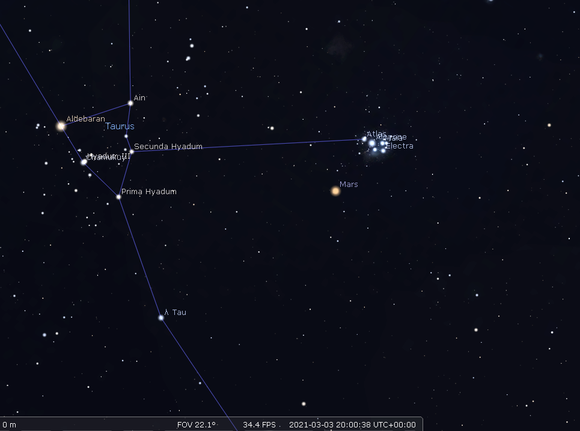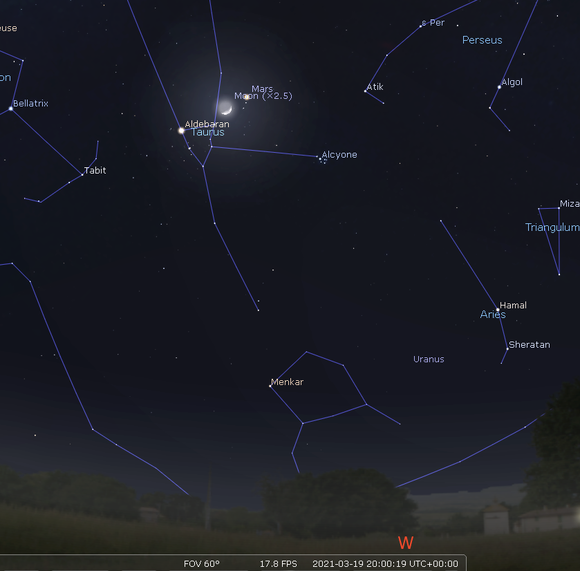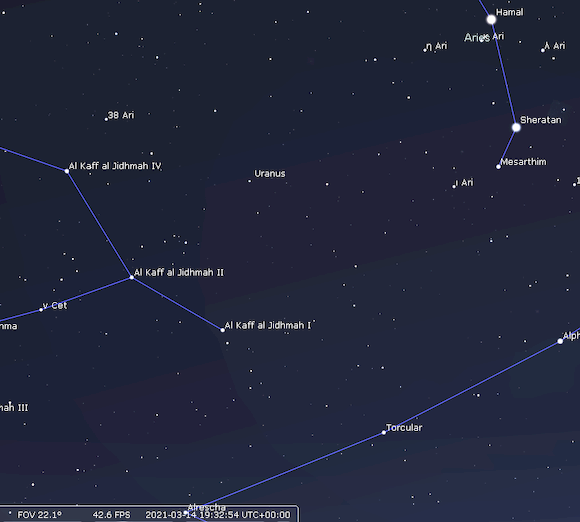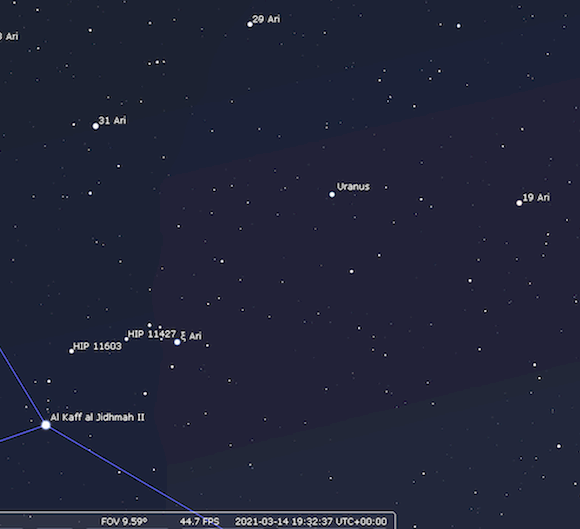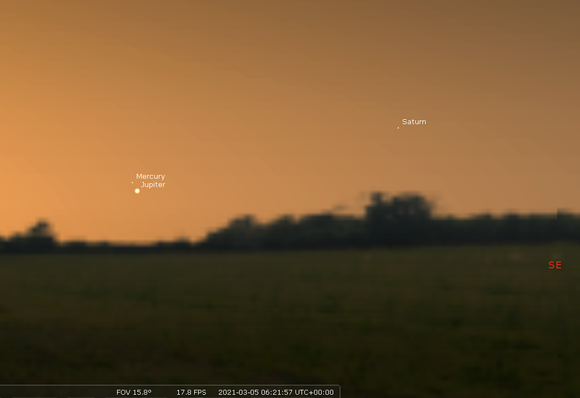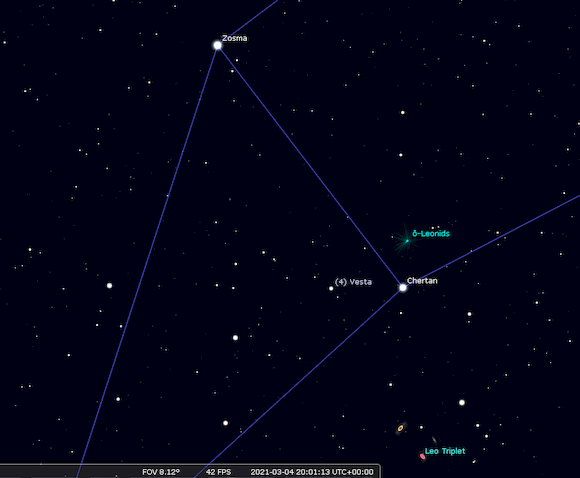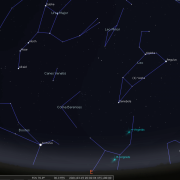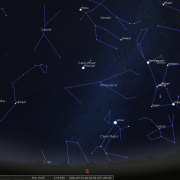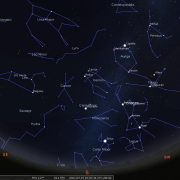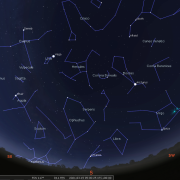In this month's Sky Notes:
Planetary Skylights - Brief
Mars remains the sole naked eye planet visible in the evening sky. Mercury, Jupiter and Saturn are awkward, hugging the ESE horizon in the dawn sky!
 Mars spends March tracking through the constellation of Taurus the Bull, passing between its two famous star clusters, the Pleiades and the Hyades. The Red planet is by now an 'ordinary' bright star of mag +0.9, not dissimilar in brightness or hue to Aldebaran; 'the eye of the bull', which sits in the Hyades star cluster and makes an interesting comparison. Indeed for a few evenings the proximity of Mars to Aldebaran almost affords the Bull a pair of eyes! Before masquerading as a second ocular, Mars first passes the magnificent Pleiades star cluster in early March, residing just under 3 degrees south-west of the Seven sisters on the 4/5th. It should make for a fine sight in 10X50 binoculars. A fine astro-imaging opportunity arrives on the evening of the 19th, when a waxing crescent moon sits between Mars and the Hyades cluster. By the months end, Mars has faded to +1.3 magnitude and will have shrunk to just over 5 arc seconds, not much of a spectacle through the eyepiece, a pity really given the headlines surrounding the safe arrival of Perseverance on Mars, and the likelyhood of more telescopes being turned toward the Red planet out of curiosity. By the start of next month Mars will be setting just before 23:00hrs.
Mars spends March tracking through the constellation of Taurus the Bull, passing between its two famous star clusters, the Pleiades and the Hyades. The Red planet is by now an 'ordinary' bright star of mag +0.9, not dissimilar in brightness or hue to Aldebaran; 'the eye of the bull', which sits in the Hyades star cluster and makes an interesting comparison. Indeed for a few evenings the proximity of Mars to Aldebaran almost affords the Bull a pair of eyes! Before masquerading as a second ocular, Mars first passes the magnificent Pleiades star cluster in early March, residing just under 3 degrees south-west of the Seven sisters on the 4/5th. It should make for a fine sight in 10X50 binoculars. A fine astro-imaging opportunity arrives on the evening of the 19th, when a waxing crescent moon sits between Mars and the Hyades cluster. By the months end, Mars has faded to +1.3 magnitude and will have shrunk to just over 5 arc seconds, not much of a spectacle through the eyepiece, a pity really given the headlines surrounding the safe arrival of Perseverance on Mars, and the likelyhood of more telescopes being turned toward the Red planet out of curiosity. By the start of next month Mars will be setting just before 23:00hrs.
 Uranus remains well placed for observation in the evening sky this month, residing just within the borders of Aries, below and left of the ‘crooked line’ asterism of the Ram marked by the stars Hamal, Sheratan and Mesatim. Uranus lies just over 1.5 degrees SE of 19 Ari. At mag +5.8 Uranus is borderline naked eye for keen sighted observers viewing from dark viewing locations (assuming they know exactly where to look). Through binoculars Uranus resembles a rather faint star, off white in hue. You will require a telescope (80mm upwards) to discern its tiny disk, which appears slightly ghoulish green in luster. During next month Uranus will become more difficult to track down, so make the most of opportunities arising this month.
Uranus remains well placed for observation in the evening sky this month, residing just within the borders of Aries, below and left of the ‘crooked line’ asterism of the Ram marked by the stars Hamal, Sheratan and Mesatim. Uranus lies just over 1.5 degrees SE of 19 Ari. At mag +5.8 Uranus is borderline naked eye for keen sighted observers viewing from dark viewing locations (assuming they know exactly where to look). Through binoculars Uranus resembles a rather faint star, off white in hue. You will require a telescope (80mm upwards) to discern its tiny disk, which appears slightly ghoulish green in luster. During next month Uranus will become more difficult to track down, so make the most of opportunities arising this month.
Dawn Sky Planets
 Jupiter begins to creep back into the dawn sky during March, brightest of the trio of planets visible just a few degrees above the ESE horizon at the start of the month, but making for tricky observations. Given that less than 30 mins will be available in which to spot these planets, forget telescopic observations, concentrate on using binoculars and then the naked eye. Although a little challenging to pick up, Jupiter is however involved in a fine close conjunction with Mercury on the 5th (see below), an event probably best appreciated through binoculars. You will need to observe shortly after 0600hrs, but no later than 0615hrs. Careful observation throughout March will reveal that Jupiter gains little in altitude with little time in which to observe it. Its time will come later!
Jupiter begins to creep back into the dawn sky during March, brightest of the trio of planets visible just a few degrees above the ESE horizon at the start of the month, but making for tricky observations. Given that less than 30 mins will be available in which to spot these planets, forget telescopic observations, concentrate on using binoculars and then the naked eye. Although a little challenging to pick up, Jupiter is however involved in a fine close conjunction with Mercury on the 5th (see below), an event probably best appreciated through binoculars. You will need to observe shortly after 0600hrs, but no later than 0615hrs. Careful observation throughout March will reveal that Jupiter gains little in altitude with little time in which to observe it. Its time will come later!
 Mercury is one of three planets skulking very low in the dawn sky not far above the ESE horizon. Not as bright as Jupiter, Mercury is nevertheless quite conspicuous and may be apparent to just the naked eye given a clear, flat horizon and right timing. View on the 5th no later than 06:20am, when it is involved in a spectacular conjunction with Jupiter. Jupiter will be by far the brighter of the pairing, with Mercury residing just 18 arc minutes above left at a respectable +0.1 magnitude. Mercury will grow a little more in brightness over the next few days, peeling off eastwards away from Jupiter, but becoming increasingly challenging to spot. It will be lost by the 12th. View no later than 06:10hrs.
Mercury is one of three planets skulking very low in the dawn sky not far above the ESE horizon. Not as bright as Jupiter, Mercury is nevertheless quite conspicuous and may be apparent to just the naked eye given a clear, flat horizon and right timing. View on the 5th no later than 06:20am, when it is involved in a spectacular conjunction with Jupiter. Jupiter will be by far the brighter of the pairing, with Mercury residing just 18 arc minutes above left at a respectable +0.1 magnitude. Mercury will grow a little more in brightness over the next few days, peeling off eastwards away from Jupiter, but becoming increasingly challenging to spot. It will be lost by the 12th. View no later than 06:10hrs.
 Saturn returned to the dawn sky shortly after Mercury at the end of February. It can be located 8 degrees to the right of Mercury and Jupiter, further round to the SE and will be a tad higher. As with the other two planets you will require an unobstructed aspect to spot it, and at mag +1.4 Saturn will be a little challenging for the naked eye initially. Binoculars will help pick it out, but a telescope will be required to make out the rings, although at this stage viewing will be poor, and with limited time availability. Like Jupiter, Saturn's time will arrive later in the year.
Saturn returned to the dawn sky shortly after Mercury at the end of February. It can be located 8 degrees to the right of Mercury and Jupiter, further round to the SE and will be a tad higher. As with the other two planets you will require an unobstructed aspect to spot it, and at mag +1.4 Saturn will be a little challenging for the naked eye initially. Binoculars will help pick it out, but a telescope will be required to make out the rings, although at this stage viewing will be poor, and with limited time availability. Like Jupiter, Saturn's time will arrive later in the year.
Vesta at Opposition
The minor planet (4) Vesta and second largest body in the asteroid belt, comes to a well placed evening opposition in Leo on March 4th. If you are viewing from really dark, transparent skies, at mag 5.85, you may even be able to spot Vesta with just the naked eye. In all probability a decent pair of binoculars or a small telescope will be your best bet, that and a couple of clear nights around opposition time! Don't expect to see Vesta as anything other than a point of light though, not the 330 mile diameter potato shaped chunk Vesta really is.
Vesta starts March in the hind quarter 'triangle' of eastern Leo to the left of theta Leonis or Chertan (mag 3.3). On the night of the 4th Vesta lies 1.2 degrees north east of Chertan and is moving 16 arc minutes per day in a north westerly motion above Chertan. Careful scrutiny of the vicinity around Chertan should reveal Vesta from night to night; given clear enough skies! If you have a long focal length telescope, you may be able to detect the motion of Vesta against the fainter background stars over the course of a few hours.
Vesta will continue moving northwest through Leo fading slightly to mag 6.2 by the end of the month. Around mid April until Vesta starts to loop back again, passing below Chertan later in the year. Good spotting!
Meteors

March continues where February left off, a lean period for meteors, with only sporadic rates for much of the month. Towards the end of March there are signs of activity from the various and complex Virginid radiant's, but numbers remain low with 'peak activity' not reached until April. The two main radiant's lie near Spica and Kappa Virginis, but typically just a few meteors per hour are recorded by an observer. True Virginids are often slow moving and long in duration, occasionally very bright (similar to Venus say) producing flares along their path. As usual the early morning hours will be most favourable.
March 2021 Sky Charts
Additional Image Credits:
- Planets and Comets where not otherwise mentioned: NASA
- Sky Charts: Stellarium Software and Starry Night Pro Plus 8
- Log in to post comments

